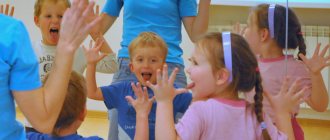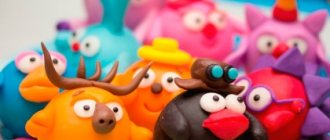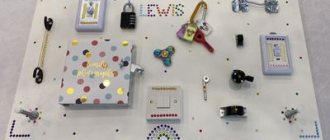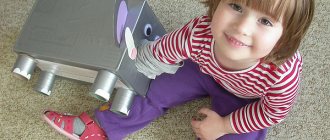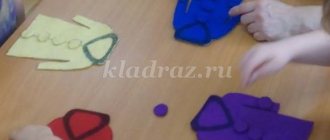What is the use of clothespins?
Ordinary clothespins can become an excellent play simulator and educational aid if you show a little imagination.
What can you use clothespins for?
- For the development of fine motor skills.
- Studying color.
- Speech development.
- Studying the account.
- Studying flowers.
- Sensory development.
- Fantasies.
- Imaginations.
- In memory.
- Attention.
- Grasping skills.
- Flexibility of the hands.
In addition, it should be borne in mind that children, from about 8 to 9 months old, enjoy tinkering with household objects much more than with toys. Cereals, cans, bottles, spoons, dishes, dad's tools, and clothespins, among others, keep kids occupied easily and for a long time.
Moreover, clothespins are much more “magical” than anything else: you can not only knock against each other, take or move them, but also bite, grab, and pinch. Parents can successfully use this fact by organizing games with clothespins - simple or using additional materials.
How to play with kids?
For the youngest children, the clothespin itself is already a toy. She can “quack” like a duck, “croak” like a frog, “bite” like a crocodile, “bark” like a dog (with the help of her mother, of course). By about one and a half years, a child will already be able to remove clothespins from various surfaces. You can take advantage of this and offer your baby the simplest games:
- “Bite” the child (only carefully) on different parts of the body (you can call them at the same time), saying that this is a crocodile who asks, for example, to be pitied.
- Attach multi-colored clothespins to yourself or to your baby, inviting him to remove these “annoying bugs.” The baby will easily succeed and will delight.
- When the child leaves the room, attach the “bugs” to different objects and ask him to find them all and remove them.
- Assemble a snake from several clothespins - the baby will be happy to take it apart.
Choose clothespins that have already been worn out and close weakly - they will not hurt the baby if he accidentally pinches his finger.
Closer to 2 years, you need to teach your child how to use such a toy independently: show how to hold it with three fingers, how to press to open it, how it closes when the fingers are released. After some training, the child will be able to do this himself. This means that you can move to a new level of games when the baby independently fastens the clothespins. Now they can turn into construction sets, colorful beads (if you string them on a string), hairpins and clips for doll hairstyles, even an abacus (also on a string, but the principle of the game is the same as when working with abacus). And they can also fulfill their role if the child washes the doll’s clothes and begins to hang them out to dry.
Play with two- or three-layer insert frames (puzzles)
Multilayer frame inserts are simply amazing toys; they combine the functions of both a puzzle and a platform for a story game. As a rule, such inset frames show the child one object in different sections, for example, a house (bus, car) inside and outside. This representation of an object contributes to the development of the child’s imaginative thinking. And it’s just incredibly interesting! Even parents
For example, the puzzle “House of Hares” (My-shop, Read) consists of the following layers: on the lowest layer the bunnies woke up and got out of their beds (in this case, you can get each hare and play a small plot game with them), on the next layer the awakened hares have already begun to carry out some kind of activity: drinking tea, taking out toys, on the third layer the house is shown from the outside and you can see what the hares are doing on the street. Here are interesting options for two-layer puzzles - House or Bus.
In this game, the child learns to distinguish the details of each layer and combine them not just by the similarity of objects (as in ordinary frame inserts), but by meaning.
Magic toy
This is true. Clothespins, if attached to the appropriate blanks, can be transformed into anything at the request of the players:
- into raindrops;
- the lights of a sun;
- legs or arms of characters;
- tree branches;
- antennae of animals or insects;
- animal ears;
- wings or tails of birds;
- tops of root crops;
- flower petals;
- fish fins, etc.
You can make a whole clothespin theater with your own hands with such details, or the open halves of clothespins can play the role of the opening mouth of the characters. Both favorite fairy tales and simple stories are played out: it’s raining, a bear is eating raspberries, a doll is picking flowers, etc. Playing nursery rhymes, tongue twisters, and nursery rhymes in this way will make learning them much more productive, because it’s exciting.
Invite your child to build a fence out of clothespins so as not to waste construction kit parts on it - they will be used to make other objects.
Learning letters and numbers for a preschooler will also become much more interesting if they are given arms and legs from clothespins and involved in various adventures (for example, the letters A and M constantly come to the baby for lunch so that he says “Am”; the evil Minus took it away from Troika One, and it turned into Two).
Letters or numbers can walk, jump, dance, fall, hold on to handles... Imagination can suggest many options for transformations for clothespins.
MAGAZINE Preschooler.RF
Games with clothespins to develop children's fine motor skillsGames with clothespins are ideal for developing fine motor skills of fingers. Unfortunately, few parents know why they need to develop fine motor skills at all. The thing is that the speech and motor centers are located nearby in the cerebral cortex, hence the connection between the sense of touch and the development of speech. The more your baby feels objects (preferably of different shapes and textures), the less likely he is to have speech problems. You can make a whole clothespin theater with your own hands with such details, or the open halves of clothespins can play the role of the opening mouth of the characters.
The proposed exercise games take into account age characteristics, give children the opportunity not to experience fatigue and do not reduce interest in activities in general. These games are useful for developing fine motor skills of the fingers and precise movements of the hands, since the muscles involved constantly send impulses to the brain, stimulating the central nervous system and promoting its development.
You need to start playing with clothespins by showing the clothespins themselves and talking about why clothespins are needed in life? Have your children ever seen clothespins at home? Where do you get clothespins? Who uses clothespins at home? Then you need to distribute clothespins to the children and explain how to press and “open” the clothespins. Let the children examine the clothespins and practice opening the clothespins, stringing the clothespins on a rope, or on the walls of a box or jar. In the future, you can play the following games:
Manufacturing of gaming equipment
You need to find not very thick, but dense cardboard, print pictures on a printer and glue them to the cardboard base, and then cut them out along the contour. It is advisable to laminate the blanks for greater durability, and if you don’t have a laminator, you can simply cover them with transparent tape. All you have to do is buy clothespins of different colors (you can also take wooden ones, which you can then paint in the desired colors).
"Sun"
This clothespin game is one of the most popular. In it, the baby needs to attach rays to the sun so that it shines brightly. Various modifications of it are possible: branches for a Christmas tree, ears for a bunny, grass, wings for a butterfly, and so on, which can be suggested to parents by their imagination. Thanks to this game, the child learns to open a clothespin, training the dexterity of his fingers and fine motor skills in general.
"Pinch-pinch"
This game is suitable for the youngest children. You need to pinch the baby's palm, fingers, tummy, legs with a clothespin. During this game, he will develop tactile sensitivity, and at the same time it will be possible to study parts of the body with him.
"Fish"
You can show your baby how the “fish” (clothespins) open their mouths and ask him to feed them. Let him try to grab small objects (coins, buttons, pasta, etc.) with a clothespin. This game perfectly develops fine motor skills and hand coordination.
"Colors"
Show your child pictures with various objects, and each of them should have the same color as the color of a certain clothespin. The baby’s task is to attach clothespins to objects of the corresponding color.
"Abacus and Beads"
Together with your baby, you can make beads from clothespins by stringing them on a cord. If the child already knows the basic colors, then he can alternate the colors of the clothespins. If you stretch a string between the legs of the chairs, you can arrange something like an abacus. With the help of such a game, you can reinforce the concepts of colors, train finger dexterity, and form the basics of counting.
"Palm"
You need to cut out a palm from cardboard, but without the fingers, and explain to the baby that they are going for a walk. He needs to return them, attaching clothespins. In this game, your child will be able to learn how to select the correct number of objects.
"Beetles"
Clothespins can be attached everywhere around the room: on the carpet, toys, books, tablecloth, curtains and tell the child that these are bugs that have fled and need to be found and sent to the box house. The game helps develop attention.
"Remove the bug from your clothes"
You need to attach multi-colored clothespins to the child or yourself and invite him to remove these bugs. With the help of this fun game, you can strengthen your child’s knowledge of body parts, basic colors, clothing, and study the concept of “left” and “right ,” right and left hands. You can chase daddy with your baby, saving him from annoying bugs.
"Grass"
The child needs to be given several strips of cardboard of different lengths, explaining that these are “clearings” , on which he is invited to plant “grass” . With the help of this game, the concepts of “long” and “short” .
"Corners"
Give the child cardboard geometric shapes, to the corners of which he must attach clothespins. With the help of this game the concept of “angle” . Older children can count the number of angles and learn what polygons are.
"Constructor"
You can make a wonderful construction set from clothespins. You can collect a lot from them: funny people, an airplane, a spider, a butterfly, etc. With the help of this creative game, a child can develop his imagination.
“Who eats what?”
You need to cut out a circle and divide it into 12 sectors, in each of which you need to draw typical food for animals, and their faces need to be cut out and glued to clothespins. It is convenient to use wooden clothespins and double-sided tape, and then you can laminate the pictures. Let the baby feed these animals. With the help of this excellent educational game, a child can find out what an elephant, panda, fox or any other animal likes to eat. And there are so many other interesting things you can do with clothespins. Play for your health!
| Next > |
Educational games
By preparing the necessary pictures or pieces from cardboard, you can achieve a more global goal than just a game: teach your child much of what is necessary for studying at school. By the way, such manuals are successfully produced and used in kindergartens. Here are some examples of such games and activities:
- Cut out a cardboard circle, mark it into several segments, paint each one a different color. In each segment, draw several points - from 1 to 5 - 9 (depending on the age of the child). Let him attach clothespins of the corresponding colors according to the number of these points. (We learn numbers, counting, colors).
- For the same purpose, you can play parcels for hedgehogs. Make several blanks of hedgehogs of different colors, write a specific number on each of them. This is exactly how many clothespins of the desired color the baby should attach instead of needles. Then he needs to collect the same number of cardboard apples of the desired color into a parcel for the corresponding hedgehog.
- Using the same principle, you can go fishing (the clothespins will be fish of different colors, you need to catch them and put them on mugs of the corresponding colors in the quantity indicated on the mug).
- The blank is also a circle made of cardboard. Only in each segment the food of different animals or birds will be drawn. Stick animals on one side of the clothespin in accordance with the food presented. The child’s task is to feed them by attaching them to the desired sector of the circle. (We study the world around us).
- Show your baby several identical objects of different sizes (these can be cards with images, things or toys - whatever will be more interesting for a particular baby). The baby’s task is to attach 1 clothespin to the smallest (low, short) object, then in ascending order 2, 3,4... (We study the values).
- Pronounce any word syllable by syllable, and let the child attach as many clothespins to a sheet of cardboard as there are syllables he can count. (Developing speech and phonemic hearing).
- Make preparations of various root vegetables (carrots, beets, turnips, radishes), “plant” them in a box with small grains (vegetable garden). The kid needs to use clothespins to “harvest the harvest”, because all the tops were eaten by pests, and it became not so easy to pull out the root crops. (We develop fine motor skills and horizons).
If parents have a developed imagination, they themselves will be able to come up with dozens more options for using such simple materials at hand for educational activities with their child.
It is possible that, having become involved in the process, the baby himself will suggest new possibilities. The main thing is not to suppress his creative impulses, to remain helpers, advisers and loving friends. Then not only clothespins, but everything that is at hand can be used. And this is a new level of development of the child’s imagination, as well as his relationship with his parents: they become allies, and not just play partners. And it all started with an ordinary clothespin...
DIY games with clothespins
For these games you will need colored cardboard and a minimum of time. It takes a couple of minutes to cut the blank, but it will last a long time.
Using clothespins, we attach rays to the sun , rain to a cloud , and plant grass in the garden bed .
We make branches for the Christmas tree , tops for carrots and turnips , and thorns for the hedgehog . Since I'm not much of an artist, I chose to print the hedgehog.
Making ears for bunnies .
This is what we do. There are more than enough such games. But you can come up with many other options : attaching legs and arms to little people, fingers to palms, paws to bugs, petals to flowers, legs to animals, wings to an airplane, leaves to a tree, etc.
And you can create three-dimensional objects by attaching, for example, legs to a table .
Multicolored circle . Another of our favorite games. Its creation will take a little more time, but the results will please you.
I cut a circle out of cardboard, divided it into 6 parts, and colored each part to match the colors of the clothespins I had. I drew circles along the outer edge: from two to five. Antoshka attaches clothespins of the corresponding color according to the number of circles. The game is well suited for children learning to count.
We feed the chick . Meet Gosha, the always hungry chick. Mommy clothespin feeds him worms. And Antoshka helps her.
It’s easy to make such a chick; in the future it can be used not only for playing with clothespins. We cut out a beak in the lid of the jar, glued the eyes, crest and wings to double-sided tape. We use hair bands, cut laces, etc. as bugs and worms.

